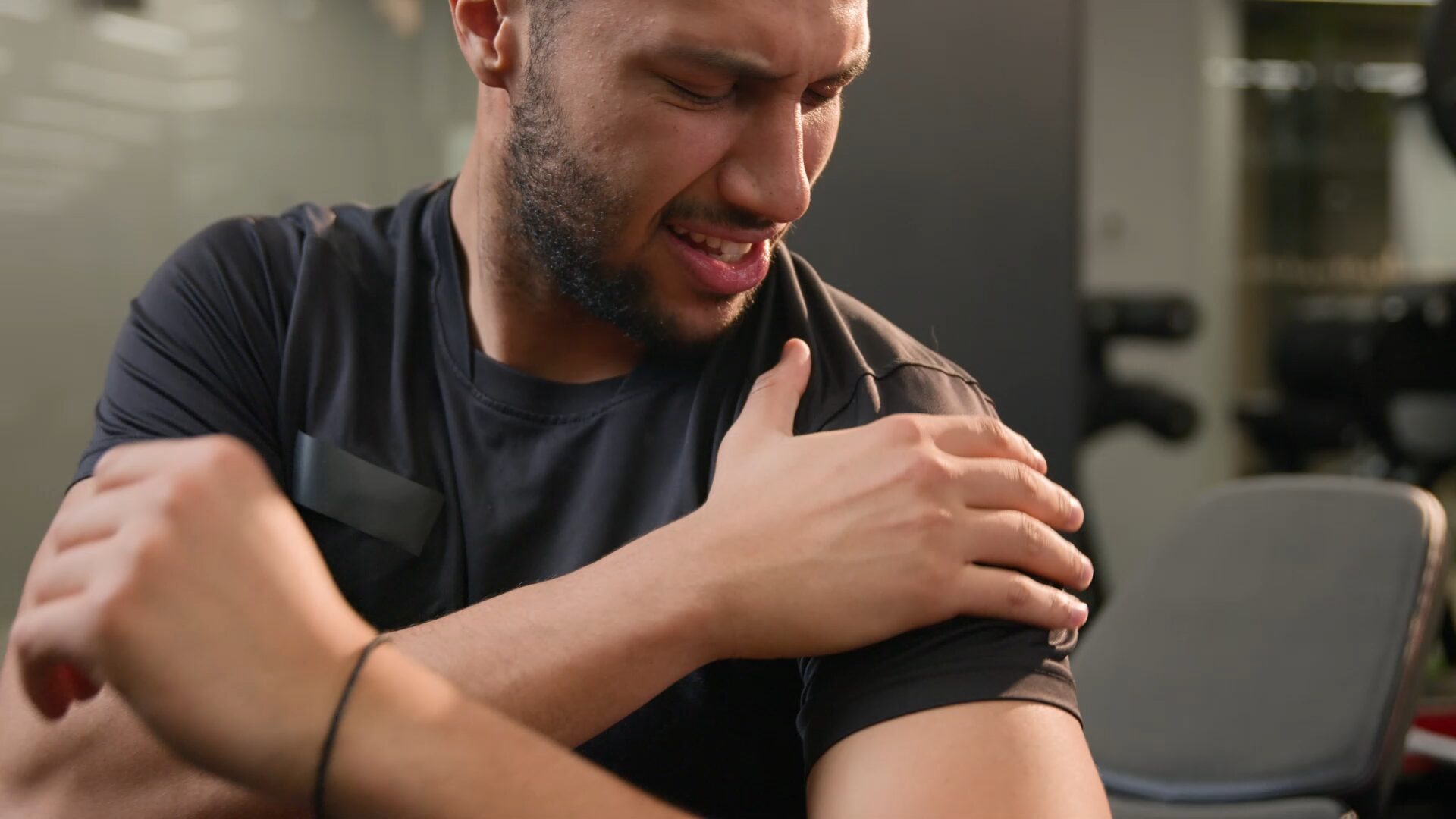
What is Shoulder Pain?
Shoulder pain refers to persistent discomfort or pain in or around the shoulder joint. This area is made up of several intricate structures, including bones, muscles, tendons, and ligaments, which all play a crucial role in supporting movement and stability. Pain in this region can result from various causes, such as injuries, overuse, or underlying medical conditions like arthritis or rotator cuff tears.

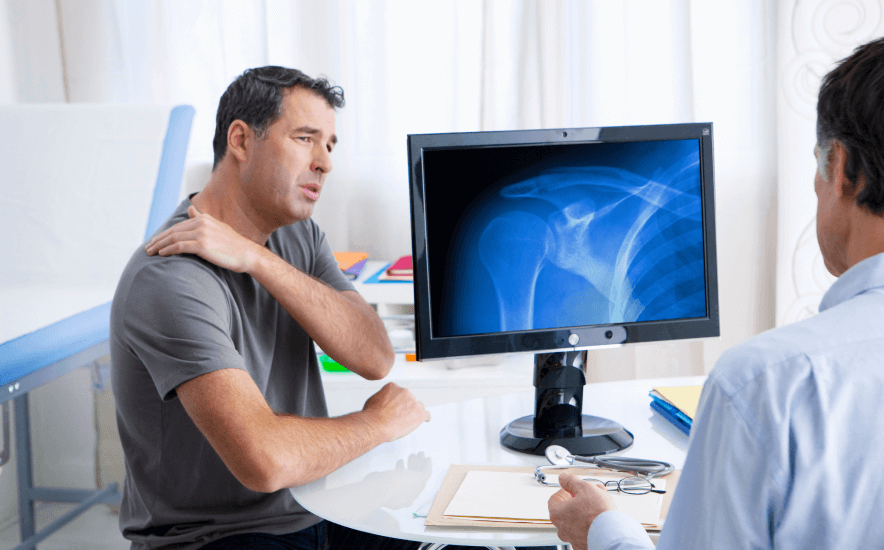
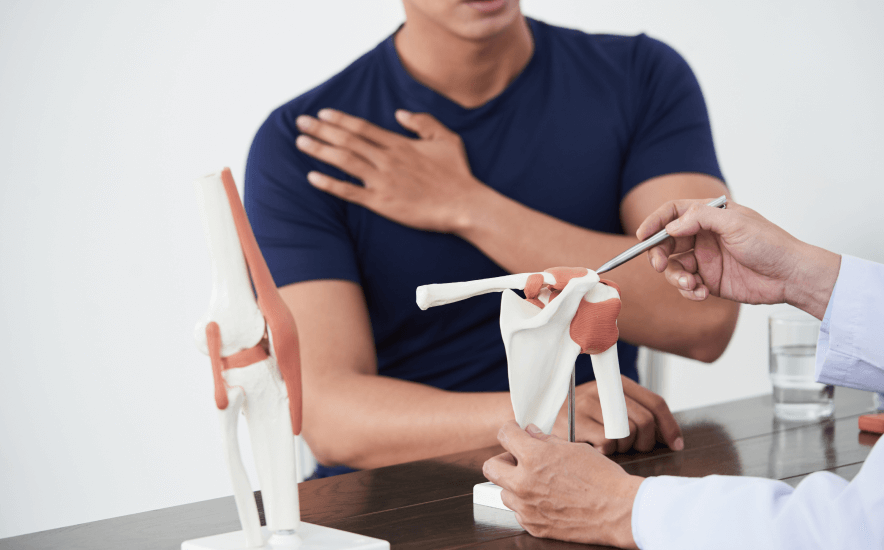
Related Diagnoses
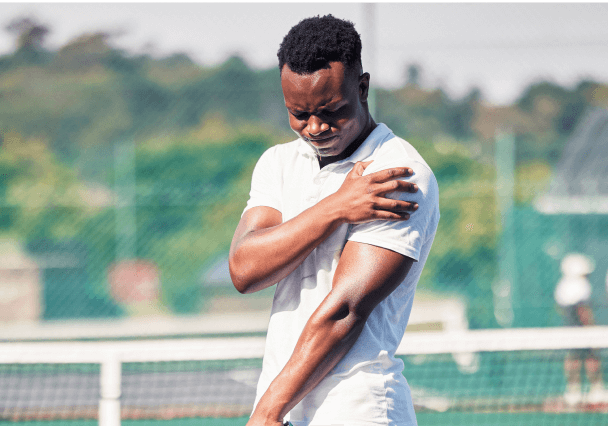
Rotator Cuff Tear

Labral Tear
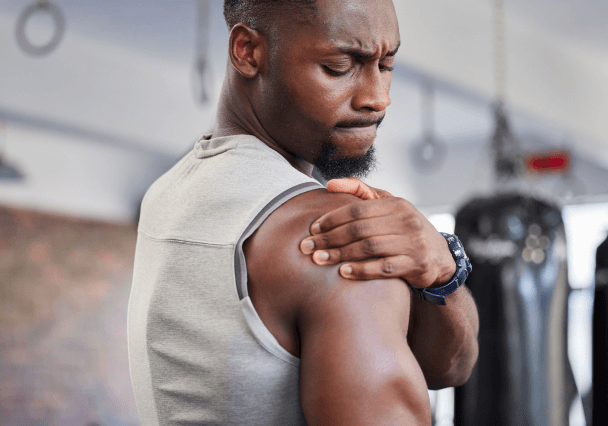
Shoulder Bursitis

Frozen Shoulder

Osteoarthritis

Post-Surgical Pain

AC Joint Pain

Bicep Tendonitis
Expanded Guide
- Rotator Cuff Tear: A rotator cuff tear is a common injury involving the muscles and tendons that stabilize the shoulder joint. These tendons allow for a wide range of arm movements, such as lifting and rotating the arm. When one or more of these tendons become torn or damaged, it can result in significant pain and loss of function. Rotator cuff tears can occur due to an acute injury, like a fall or lifting something heavy, but more often they develop gradually due to wear and tear, especially in older adults or individuals who engage in repetitive shoulder activities. There are two main types of rotator cuff tears: partial tears, where the tendon is damaged but not completely severed, and full-thickness tears, where the tendon is completely torn, often pulling away from the bone. Symptoms typically include shoulder pain, weakness, reduced range of motion, and difficulty performing activities like lifting the arm overhead.
- Labral Tear: A labral tear is an injury to the labrum, the ring of cartilage that surrounds the shoulder socket (glenoid), which helps stabilize the shoulder joint by deepening the socket and keeping the ball of the upper arm bone (humerus) in place. This type of tear can occur due to trauma, such as a fall or sudden impact, or from repetitive shoulder motions, commonly seen in athletes who engage in overhead activities like throwing or swimming. There are different types of labral tears, with the most common being SLAP (Superior Labrum Anterior and Posterior) tears, which occur at the top of the labrum where the biceps tendon attaches, often caused by repetitive motions or a sudden pull on the arm. Another common type is the Bankart tear, which occurs in the lower part of the labrum and is often associated with shoulder dislocations. Symptoms of a labral tear include pain, instability, a catching or locking sensation in the shoulder, and weakness.
- Shoulder Bursitis: Bursitis is the inflammation of a bursa, which is a small, fluid-filled sac that acts as a cushion between bones, tendons, muscles, and skin around joints. The bursae help reduce friction and allow smooth movement of the muscles and tendons over bones. When a bursa becomes irritated or inflamed, it leads to bursitis, causing pain, swelling, and limited movement in the affected joint. Bursitis commonly occurs in areas such as the shoulder, elbow, hip, and knee. The condition can be caused by repetitive movements or prolonged pressure on a joint, such as frequent kneeling or leaning on the elbows, but it can also develop from injury, infection, or underlying conditions like arthritis. Symptoms of bursitis include localized pain, tenderness, swelling, and reduced range of motion.
- Frozen Shoulder: Frozen shoulder, also known as adhesive capsulitis, is a condition characterized by stiffness, pain, and limited range of motion in the shoulder joint. It occurs when the connective tissue capsule surrounding the shoulder joint thickens and tightens, leading to adhesions that restrict movement. While the exact cause is often unclear, frozen shoulder is frequently associated with periods of immobility, such as after an injury, surgery, or illness. The condition develops in three stages: the freezing stage, where shoulder movement becomes painful and range of motion decreases; the frozen stage, where pain may lessen but stiffness and limited movement become more prominent; and the thawing stage, where the shoulder slowly regains its range of motion. This process can last anywhere from 1 to 3 years. Frozen shoulder is more common in people over 40 and those with conditions like diabetes or thyroid disorders.
- Osteoarthritis: Shoulder osteoarthritis is a degenerative condition that affects the shoulder joint, specifically the cartilage that cushions the ends of the bones. In a healthy shoulder, this cartilage allows smooth movement between the ball of the upper arm bone (humerus) and the shoulder socket (glenoid). With osteoarthritis, the cartilage gradually wears down, leading to friction between the bones, which causes pain, stiffness, swelling, and reduced range of motion. Over time, this friction can result in the formation of bone spurs and changes in the joint’s shape. Shoulder osteoarthritis can develop due to aging, previous injuries to the shoulder (such as fractures or dislocations), or chronic wear and tear from repetitive use. While less common than osteoarthritis in weight-bearing joints like the hips or knees, it can still significantly impact daily activities. Symptoms often worsen with time, starting with mild discomfort and progressing to more persistent pain, especially during movement or at night.
- Post-Surgical Pain: Post-surgical shoulder pain refers to discomfort or ongoing pain that occurs after shoulder surgery. While surgery is meant to address pain or structural problems in the shoulder, it is common to experience some pain during the recovery process. This pain can range from mild to severe, depending on the type of surgery, the patient’s healing, and any complications. Causes of post-surgical shoulder pain include the normal healing process, surgical trauma to muscles or ligaments, scar tissue formation, nerve irritation, or rare complications such as infections or issues with surgical hardware. Symptoms typically include shoulder pain, stiffness, reduced range of motion, swelling, and sometimes numbness or tingling if nerves are involved.
- AC Joint Pain: An acromioclavicular (AC) joint injury occurs when the joint at the top of the shoulder, where the clavicle (collarbone) meets the acromion (part of the shoulder blade), is damaged. This type of injury is common in sports or activities involving falls or direct impacts to the shoulder. The severity of AC joint injuries ranges from mild sprains (Grade 1) to complete dislocations (Grade 3 or higher). These injuries are typically caused by direct trauma, such as falling onto the shoulder, or indirect trauma, like falling on an outstretched hand. Symptoms include pain at the top of the shoulder, swelling, tenderness, and in more severe cases, visible deformity due to the displacement of the clavicle.
- Bicep Tendonitis: Bicep tendonitis is the inflammation or irritation of the tendons that connect the biceps muscle to the shoulder and elbow, most commonly affecting the long head of the biceps tendon at the top of the shoulder. It is typically caused by overuse, repetitive motions, or wear and tear from activities involving frequent lifting or overhead movements, making it common among athletes in sports like swimming, tennis, or weightlifting. Aging, shoulder impingement, or sudden injuries can also lead to bicep tendonitis. Symptoms include pain in the front of the shoulder, tenderness, weakness, and sometimes a clicking or snapping sensation during movement.
Frequently Asked Questions
Have more questions? Schedule a consultation with Dr. Patel to gain additional insights and discuss treatment options. We are committed to advancing your health through patient education and a safe, minimally invasive approach.
Diagnosing shoulder pain typically involves a physical examination, medical history review, and imaging tests such as X-rays, MRI, or ultrasound. These tools help determine the underlying cause, whether it’s soft tissue damage, joint degeneration, or other issues.
Treatment depends on the cause and severity of the pain. Common treatments include rest, physical therapy, anti-inflammatory medications, corticosteroid injections, and, in severe cases, surgery. Maintaining shoulder mobility through stretching and strengthening exercises can also be beneficial.
The duration of shoulder pain can vary widely depending on the cause and severity of the condition. For minor injuries like mild strains or tendinitis, shoulder pain may resolve within a few days to a few weeks with rest, ice, and appropriate treatment. Conditions such as tendinitis or bursitis often improve within 2 to 6 weeks if treated properly. However, more serious issues, such as rotator cuff tears or frozen shoulder, can lead to prolonged discomfort. For example, frozen shoulder can take 1 to 3 years to fully resolve, with each phase (freezing, frozen, and thawing) lasting several months. Recovery from more severe rotator cuff injuries, particularly those requiring surgery, can take several months to over a year. The duration of recovery is influenced by the type of injury, treatment received, and adherence to rehabilitation plans. If pain persists beyond a few weeks despite treatment, seeking medical advice is recommended.
Untreated or poorly managed shoulder pain can lead to several complications that affect both mobility and quality of life. One major risk is the development of chronic pain, which can become persistent and interfere with daily activities like lifting, dressing, or even sleeping. In addition, conditions such as rotator cuff tears, frozen shoulder, or arthritis can result in a permanent loss of range of motion, making it difficult to move the arm. Prolonged immobility can also cause weakness and muscle atrophy, further limiting the shoulder's functionality. Joint instability is another potential complication, especially if injuries like labral tears or dislocations are left untreated, increasing the risk of recurrent dislocations. Over time, chronic shoulder pain may lead to compensatory movement patterns, where other muscles and joints (like the neck or back) take on more strain, causing secondary pain in those areas. If left unmanaged, some conditions may worsen and eventually require surgical intervention, such as rotator cuff repair or shoulder replacement.
Gramercy Center
Take the first step towards a healthier life by scheduling your initial consultation with Dr. Patel. At our clinic, we specialize in minimally invasive procedures that offer faster recovery, improved function, and decreased pain. Our client-centered approach ensures that you receive the highest quality care tailored to your unique needs. We look forward to offering you an exceptional experience.
